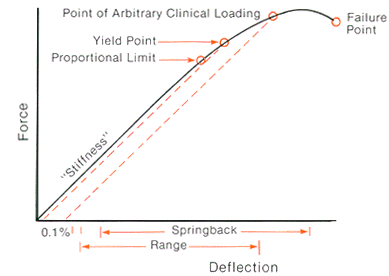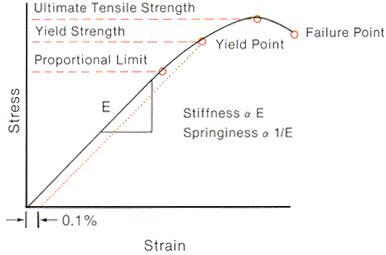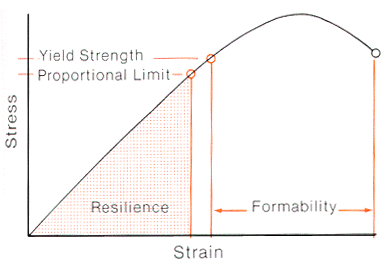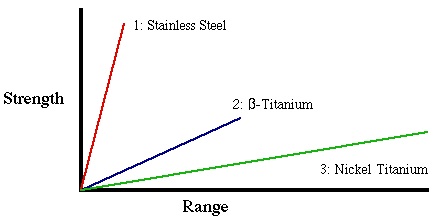

|
|
|
There are three points on a force-deflection curve that represent strength. Studying materials using a graph is very helpful because "a picture is worth a thousand words."
Strength:
Strength is the measure of the force a material can withstand before the material permanently deforms. Strength may be viewed in these three ways:
Stiffness:
Stiffness is proportional to the slope of the linear portion of the graph of the force-deflection curve of a material. The linear portion ranges from zero to the proportional limit. The steeper the slope, the stiffer the material. Range:
Range is the deflection the material will encounter before any permanent deformation occurs - from zero to the proportional limit. Beyond the proportional limit, the material will bend, but it will not return to its original shape. There is, however, a limit to the amount of bending beyond the proportional limit to which you can bend a material - the failure point is were it breaks. Make sure that you know that the range is in units of length and strength is in units of force! Internal stresses and external strains are characteristics of a material that can be calculated from the force-deflection curve. This relationship explains the similarity in the shapes of the force-deflection and stress-strain curves. The slope of the stress-strain curve is the elastic modulus (E) and is proportional to the stiffness.
Two other characteristics of orthodontic materials can be determined from a stress-strain curve. Resilience:
Resilience is the area under the curve out to the proportional limit. Resilience represents the energy capacity of the material that is a combination of the strength and stiffness. Formability:
Formability is the amount of permanent deformation that a material can withstand before breaking.
Here are some force-deflection curves for some common orthodontic wires. Note that for the sake of simplicity, the graph only shows the linear portion of the curve. Force (strength) is the y-axis and deflection (range) is the x-axis.
Which has the greatest strength (1,2 or 3)?
Which has the greatest stiffness (1,2 or 3)?
Which has the greatest range (1,2 or 3)?
Which has the greatest resilience (1,2 or 3)?
Last Update: August 19,1998 Please direct questions and comments about this page to appl@net.chem.unc.edu Designed in cooperation with The Shodor Education Foundation, Inc. © Copyright 1998 The University of North Carolina at Chapel Hill |




